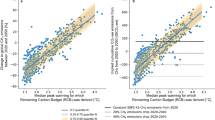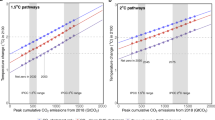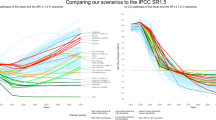Abstract
The United Nations Framework Convention on Climate Change1 calls for “stabilization of greenhouse-gas concentrations in the atmosphere at a level that would prevent dangerous anthropogenic interference with the climate system . . . ”. A standard baseline scenario2,3 that assumes no policy intervention to limit greenhouse-gas emissions has 10 TW (10 × 1012 watts) of carbon-emission-free power being produced by the year 2050, equivalent to the power provided by all today's energy sources combined. Here we employ a carbon-cycle/energy model to estimate the carbon-emission-free power needed for various atmospheric CO2 stabilization scenarios. We find that CO2 stabilization with continued economic growth will require innovative, cost-effective and carbon-emission-free technologies that can provide additional tens of terawatts of primary power in the coming decades, and certainly by the middle of the twenty-first century, even with sustained improvement in the economic productivity of primary energy. At progressively lower atmospheric CO2-stabilization targets in the 750–350 p.p.m.v. range, implementing stabilization will become even more challenging because of the increasing demand for carbon-emission-free power. The magnitude of the implied infrastructure transition suggests the need for massive investments in innovative energy research.
This is a preview of subscription content, access via your institution
Access options
Subscribe to this journal
Receive 51 print issues and online access
$199.00 per year
only $3.90 per issue
Buy this article
- Purchase on Springer Link
- Instant access to full article PDF
Prices may be subject to local taxes which are calculated during checkout



Similar content being viewed by others
References
United Nations Framework Convention on Climate Change (Text) (UNEP/WMO, Climate Change Secretariat, Geneva, 1992).
Leggett, J. et al. in Climatic Change 1992: the Supplementary Report to the IPCC Scientific Assessment (eds Houghton, J. T. et al.) 69–95 (Cambridge Univ. Press, 1992).
Houghton, J. T. et al. (eds) Climate Change 1995: the Science of Climate Change (Cambridge Univ. Press, 1996).
Kaya, Y. Impact of carbon dioxide emission control on GNP growth: Interpretation of proposed scenarios (IPCC Response Strategies Working Group Memorandum, 1989).
Nakićenović, N., Victor, D., Grübler, A. & Schrattenholtzer, L. Long term strategies for mitigating global warming: Introduction. Energy 18, 403–409 (1993).
Hoffert, M. I. & Potter, S. D. in Engineering Response to Global Climate Change (ed. Watts, R. G.) 205–260 (Lewis, Boca Raton, FL, 1997).
de Vries, B. & van den Wijngaart, R. The Targets/IMage Energy (TIME) 1.0 Model (GLOBO Rep. Ser. No. 16, National Institute of Public Health and the Environment (RIVM), Bilthoven, Netherlands, 1995).
Nakićenović, N. Freeing energy from carbon. Daedalus 125(3), 95–112 (1996).
Boden, T. A. et al. (eds) Trends 93: A Compendium of Data on Global Change 501–584 (ORNL/CDIA-65, Carbon Dioxide Information Analysis Center, Oak Ridge National Lab., Oak Ridge, TN, 1994).
Alcamo, J. et al. in Climate Change 1994 (eds Houghton, J. T. et al.) 247–304 (Cambridge Univ. Press, Cambridge, UK, 1995).
Alcamo, J. (ed.) Image 2.0: Integrated Modeling of Global Climate Change (Kluwer, Netherlands, 1994).
Pepper, W. J. et al. Emission Scenarios for the IPCC—An Update (US Environmental Protection Agency, Washington DC, 1992).
Yang, C. & Schneider, S. H. Global carbon dioxide scenarios: sensitivity to social and technological factors in three regions. Mitigat. Adapt. Strat. for Global Change 2, 373–404 (1998).
Reddy, A. K. N. & Goldemberg, J. in Energy for Planet Earth (ed. Piel, J.) 59–71 (Freeman, New York, 1991).
Goldemberg, J. Energy needs in developing countries and sustainability. Science 269, 1058–1059 (1995).
Wigley, T. M. L., Richels, R. & Edmonds, J. A. Economic and environmental choices in the stabilization of atmospheric CO2concentration. Nature 379, 240–243 (1996).
Jain, A. K., Kheshgi, H. S., Hoffert, M. I. & Wuebbles, D. J. Distribution of radiocarbon as a test of global carbon cycle models. Glob. Biogeochem. Cycles 9, 153–166 (1995).
Romm, J., Levine, M., Brown, M. & Peterson, E. Aroad map for U.S. carbon reductions. Science 279, 669–670 (1998).
National Academy of Sciences Policy Implications of Greenhouse Warming 340–375 (National Academy Press, WashingtonD, 1992).
Parson, E. A. & Keith, D. W. Fossil fuels without CO2emissions: Progress, prospects and policy implications. Science (in the press).
Steinberg, M. & Dong, Y. in Global Climate Change: Science, Policy and Mitigation Strategies (eds Mathai, C. V. & Stensland, C.) 858–873 (Air & Waste Management Assoc., Pittsburgh, PA, 1994).
Marland, G. (ed.) Special section on geoengineering. Clim. Change 33(3), 275–336 (1996).
Flannery, B. P. et al. in Engineering Response to Global Climate Change (ed. Watts, R. G.) 379–427 (Lewis, Boca Raton, FL, 1997).
Fogg, M. J. Terraforming: Engineering Planetary Environments (SAE International, Warrendale, PA, 1995).
Schneider, S. H. & Goulder, L. H. Achieving low-cost emission targets. Nature 389, 13–14 (1997).
Johansson, T. M. et al. (eds) Renewable Energy (Island, Washington DC, 1993).
Glaser, P. E. et al. (eds) Solar Power Satellites: A Space Energy System for Earth (Wiley-Praxis, Chichester, 1998).
Weinberg, A. M. in Technologies For a Greenhouse-Constrained Society (eds Kuliasha, M. A. et al.) 227–237 (Lewis, Boca Raton, FL, 1992).
Fowler, T. K. The Fusion Quest (Johns Hopkins, Baltimore, 1997).
Grüber, A. in Technological Trajectories and the Human Environment (eds Ausubel, J. H. & Langford, H. D.) 14–32 (National Academy Press, Washington DC, 1997).
Acknowledgements
We thank DOE, NASA and NSF for partial support of this work. We also thank the Aspen Global Change Institute for discussions during the 1998 summer workshop ‘Innovative Energy Systems and CO2 Stabilization’.
Author information
Authors and Affiliations
Corresponding author
Rights and permissions
About this article
Cite this article
Hoffert, M., Caldeira, K., Jain, A. et al. Energy implications of future stabilization of atmospheric CO2 content. Nature 395, 881–884 (1998). https://doi.org/10.1038/27638
Received:
Accepted:
Issue Date:
DOI: https://doi.org/10.1038/27638
This article is cited by
-
Ultra-selective uranium separation by in-situ formation of π-f conjugated 2D uranium-organic framework
Nature Communications (2024)
-
A cryogenic ultra-strong and ductile steel induced by stable nanoscale dual-phase structure
Journal of Materials Science (2023)
-
Theoretical analysis of homogeneous catalysis of electrochemical reactions: steady-state current–potential
Reaction Kinetics, Mechanisms and Catalysis (2023)
-
Active repair of a dinuclear photocatalyst for visible-light-driven hydrogen production
Nature Chemistry (2022)
-
Review of nanomaterials impact on improving the performance of dye-sensitized and perovskite solar cells
Optical and Quantum Electronics (2022)
Comments
By submitting a comment you agree to abide by our Terms and Community Guidelines. If you find something abusive or that does not comply with our terms or guidelines please flag it as inappropriate.



